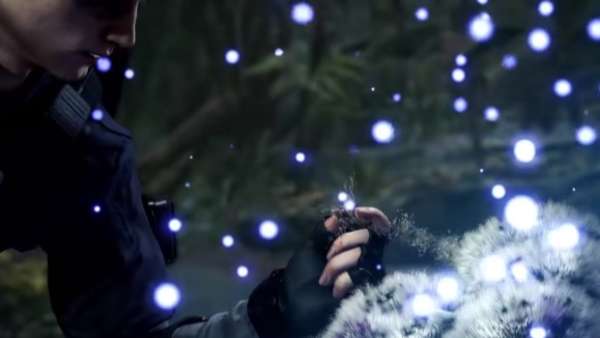| Resident Evil: Revelations |
| Players 2 |
| Surival Horror |
| PS3 | PC | 360 | Wii U |
It has been a while since Resident Evil could be considered true survival horror. Years of stagnation have replaced tense moments and atmosphere with quick-time events and jump-scares. The newest console release for the franchise is Resident Evil: Revelations which gives a HD upgrade to the well received 2012 3DS outing. But does this adventure scare players to death, or hammer another nail into the coffin?
While Resident Evil: Revelations primarily follows the gameplay tropes of the last three core releases in the series, it mixes them to create a slightly fresher gameplay experience. Over the shoulder shooting and slowly encroaching creatures is once again the core gameplay, but does a tighter focus and cutting many of the tertiary elements aid the gameplay or make it seem anaemic?
Taking place between Resident Evil 5 and 6, the story surprisingly manages to rip itself away from the convoluted series law. Establishing a tight story around anti-terrorism organisation BSAA and the bio-terrorist group Il Veltro, Revelation is free to tell a new story set in the Resident Evil universe while giving a few nods to the series older instalments. The story primarily follows series favourites Jill Valentine and Chris Redfield as they discover the new horrors created from the “t-Abyss” virus.
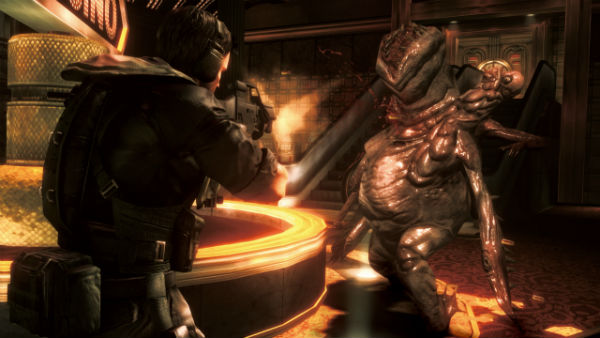
Slippery When Wet
Even though the plot isn’t bogged down in series lore, the dialogue can almost be on par with the first Resident Evil. Drifting from passable to laughably bad, one-liners and character chatter comes off as wooden and poorly acted. The script at times comically bad, coming across as if there is one big joke at the players expense. It can at times seem as if the lines were written to equal “master of unlocking” and “Jill sandwich”.
For once the story takes itself out of the shadow of Raccoon City, or an exotic village in a vague location of the globe. Although a few short areas take place in exotic locales, the majority of Resident Evil: Revelations actions take place on-board the derelict ship SS Queen Zenobia, a long abandoned cruise liner left floating in the ocean.
Many elements have been done away with for the sake of streamlining the game. Upgrades are now found and aren’t weapon specific and merchants don’t appear every couple of rooms. The inventory is a stripped down mix of 4 and 5, with a specific number of slots to fill but opening it now pauses gameplay. Items no longer need to be customised, doing away with an inventory full of multicoloured herb mixtures. Healing is as easy pressing a button when the screen is red, no longer breaking the flow to apply it via the inventory screen. Inventory management sessions no longer take more than a few moments and scouring every room with the new “Genesis” augmented reality scanner to find hidden items is quick and simple. Taking the time to scan enemies yields further rewards, with continued use giving recovery items. It keeps the game on the straight and narrow, and the pacing is better for it.
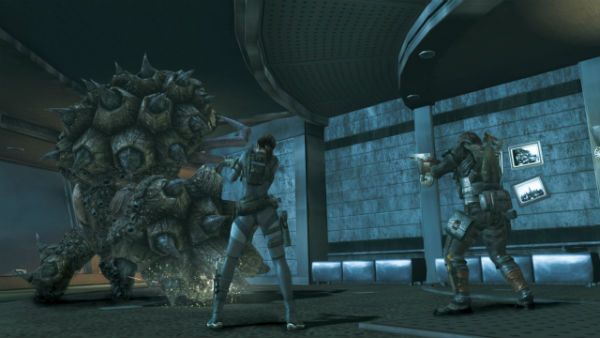
Giant Zombie Hedgehogs Are A Very Real Threat
Sound design that knows when less is more and cramped environments create tension in ways that the recent iterations of the series have failed to illicit. Areas are designed to work to the enemy’s advantage, enabling them to slither out of air-ducts and appear from almost nowhere. Being flanked and overrun is a very real threat that will catch players off-guard if they are used to the relatively stupid AI the series has used before. While this isn’t necessarily scary, it does lead to some very uncomfortable situations with monsters constantly encroaching inwards with the player given very little room to manoeuvre. Moments set in more open spaces and set pieces that place restrictions on the player create a game that feels like it was created to work against them, without feeling unfair.
The liner itself is surprisingly large, sporting many decks with interesting thematic variations that keeps the experience of investigating her mysteries a constantly creepy one. Constant illusions to the Divine Comedy run parallel to the themes of delving deeper into the bowels of hell. The upper decks are filled with cold greys, maintained by the ever-present storm outside, and the lower decks give way to a warmer atmosphere with the décor akin to the Spencer mansion. These differing environments make sure that the ten hour campaign doesn’t become too much of a bore and keep it well varied. This is aided further by occasional non-chronological side-story which focus on other characters elsewhere in the world.
Resident Evil: Revelations keeps the pacing of the 3DS version, which works to the console versions advantage. Short, sharp levels and chapters are placed perfectly to not overstay their welcome and deliver a great dose of tense action. Cut-scenes rarely over-run, keeping the story free of useless moments and content, even if sometimes the dialogue can be a special kind of bad.
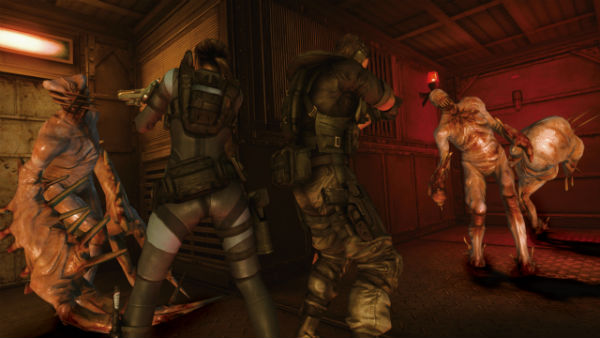
The Name “Ooze” is very Appropriate
Surprisingly for a port of a handheld game, Resident Evil: Revelations keeps a large amount of graphical fidelity. Even though the visuals not ground-breaking, texture resolution and effects rarely ever look slipshod. Up close however a few objects appear less-detailed and sub-par. Even though these are in the minority the lack of detail in them makes them stand out more, tarnishing the games overall look.
Enemies are well animated with horrific creatures shambling and oozing with horrendous detail. Rain and snow effects bombard the environments and lighting creates stark contrast from the bright first class decks, to the dark, dingy lower areas. Even with the cameras odd obsession with Jill’s rear-end, the world is well presented with detail that betrays its portable roots for the most part.
Resident Evil: Revelations doesn’t stray too far from the previous series games. Over-the-shoulder combat and a gradual increase in power and edge. The upgrade system is simple and the weapons are nothing out of the ordinary. Combat moves at a quick pace and the game gives enough occasional respite to prevent over-saturation.
Levels follow a predictable flow that require finding a specific door to move forward, finding a key to that door and fighting your way through legions of horrid beasts to finish the chapter. Even though it is not overly inspired the game follows an enjoyable path that ends satisfyingly.
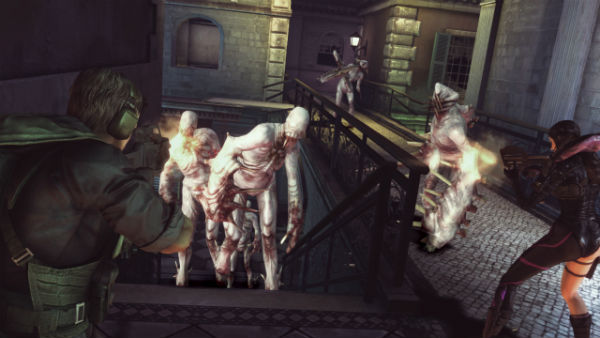
Numbers Are Rarely On Your Side
Mercenaries mode makes a return, re-dubbed Raid Mode. Allowing up to two players to face of against a map with altered enemy layouts. Featuring a simple levelling system, Raid Mode strips away most of the single-player mechanics to make way for a focused action experience. With additional HUD information such as weapon damage and enemy life, it gives a Borderlands-lite feel for those who wished it was a little more serious. While not worthy enough of being the core focus. It does well enough to add more longevity for those who enjoy it.
The higher definition version doesn’t add more than an extra difficulty and a few extra Raid Mode characters, it is more than worthy than its recent console based cousins. Minor issues keep Revelations from being out-rightly scary, but it is a much more tense and uncomfortable game than any of the core series iterations in years.
Resident Evil: Revelations is by no means perfect, but it does enough right to show a glimmer of hope for fans who want a return to form for the franchise. Tightly designed mechanics and a rich atmosphere keep it engaging and fun to play. While held back by a sub-par story and voice-acting, it is easily enjoyable enough to forgive for those who want an action game that isn’t always going full-throttle.
+ | Simple, Well Executed Mechanics | – | Poor Story And Voice Acting |
+ | Creates Tension That Pays Off | – | Some visuals look handheld quality |
+ | Well Paced Campaign |
|
|
+ | Developed Raid Mode |
|
|
| Resident Evil: Revelations : 80% Uncovered |


